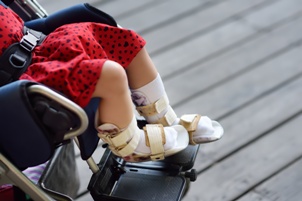 Cerebral palsy is a term commonly used to describe a group of health conditions that impact a person’s movement. Not all types of cerebral palsy are the same, however, and to help your child after a cerebral palsy diagnosis, it is essential to understand your child’s specific type of cerebral palsy, how your child may have developed it, and what steps you can take to protect your child’s future.
Cerebral palsy is a term commonly used to describe a group of health conditions that impact a person’s movement. Not all types of cerebral palsy are the same, however, and to help your child after a cerebral palsy diagnosis, it is essential to understand your child’s specific type of cerebral palsy, how your child may have developed it, and what steps you can take to protect your child’s future.
Dyskinetic Cerebral Palsy: Symptoms, Diagnosis, and Treatment
Dyskinetic cerebral palsy occurs when there is an injury or medical issue that impacts the basal ganglia part of the brain. The basal ganglia sends messages from the brain to the muscles. When those messages are incorrectly sent, a person may have trouble controlling movements.
Dyskinetic Cerebral Palsy Symptoms
Dyskinetic cerebral palsy can be further broken down into two categories: athetoid cerebral palsy and dystonic cerebral palsy.
Symptoms of athetoid cerebral palsy include:
- Involuntary movements that make a child appear to be constantly moving
- Involuntary movements of the tongue and lips which make talking, eating, and drinking difficult
- Drooling
- Difficulty grasping rattles, toys, bottles, or utensils with their hands
Symptoms of dystonic cerebral palsy include:
- Stiff muscles
- Pain
The entire body, or just part of the body, may be impacted by dystonic cerebral palsy.
Diagnosing Dyskinetic Cerebral Palsy
Doctors may utilize one of several tests to diagnose dyskinetic cerebral palsy in children, including:
- Observations of the child and conversations with parents
- An MRI of the basal ganglia area of the brain
- An EEG that looks at electrical activity in the brain
- An EMG that measures muscle weakness
Speech, hearing, and vision tests may also be part of a diagnosis, and a doctor may perform additional tests to rule out other conditions.
Treatment of Dyskinetic Cerebral Palsy
Dyskinetic cerebral palsy, like other forms of cerebral palsy, is currently incurable, but treatments are available to help people manage their symptoms. Your child’s team of doctors will develop a treatment plan, which may include:
- Physical therapy
- Occupational therapy
- Assistive medical devices such as leg braces or wheelchairs
- Surgeries
- Medications
Your child’s treatment plan may begin even before a definitive diagnosis is made and continue for the rest of your child’s life.
Dyskinetic Cerebral Palsy Birth Injury Recoveries
The costs of dyskinetic cerebral palsy can add up quickly. Consider your child’s:
- Lifelong medical treatments and expenses
- Ability to work and be independent
- Physical pain and emotional suffering
- Other costs that would not have to be paid if your child did not suffer from the disorder
If medical negligence caused your child’s cerebral palsy, you should not have to bear these expenses alone. Instead, you have the right to pursue a birth injury case against the hospital, nurse, or doctor whose negligence caused your child’s cerebral palsy.
A common cause of cerebral palsy is oxygen deprivation during labor and delivery. Oxygen deprivation caused by any of the following may be considered medical malpractice:
- Umbilical cord wrapped around the baby’s neck
- Twisted, compressed, or otherwise damaged umbilical cord
- Damaged placenta
- Prolonged or difficult labor or delivery
If it can be proven that another hospital, nurse, or doctor would have taken steps that differed from the steps your hospital, nurse, or doctor took, you may have cause for a medical malpractice lawsuit on behalf of your child.
You have a limited time to take action to protect your child’s legal rights. It is up to you to make the first call to a birth injury law firm. Once you call Gray and White Law, our experienced birth injury lawyers and staff nurse will thoroughly investigate what happened to your child, advise you of your child’s legal rights, fight hard to get your child a fair financial recovery, and hold the hospital, nurse, or doctor accountable so that another child is not hurt in a similar way. Please call us or start an online chat with us at any time to learn more.
Related Links: